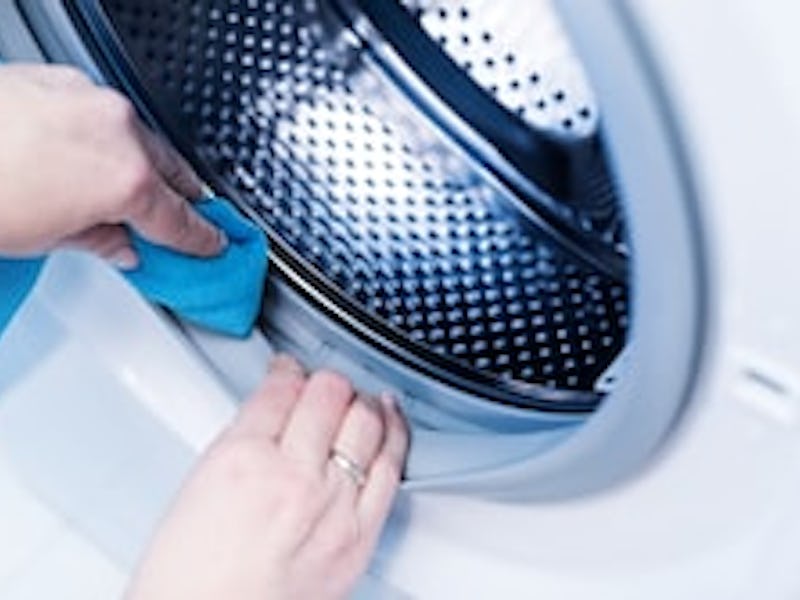No, your high-efficiency washing machine probably isn't harboring pathogens
As long as you take reasonable cleaning measures, you should be fine.

News began circulating at the end of the week that high-efficiency washing machines could be harboring dangerous bacteria, but before you throw out your appliances, you should probably know that those fears are overblown.
The news comes from a study released Friday in the journal Applied and Environmental Microbiology, which describes how one washing machine in a German hospital spread drug-resistant bacteria to infants in a neonatal unit by way of freshly washed caps and socks. Once the washing machine was discovered to be the source of the bacteria, the machine was removed from the hospital. The children — who had been colonized but not infected — returned to normal.
On its face, the results sound terrifying and have stirred up new concern about the safety of washing machines — and in particular high-efficiency ones which run colder water in order to save energy.
But for a couple of different reasons, this concern is largely unwarranted.
It wasn’t a high-efficiency machine
First of all, the washing machine in question doesn’t appear to have been low-energy after all: The study’s authors write that “a [149 °F] washing program had been used for every wash cycle,” which is several degrees warmer than the “well below 60°C (140°F)” that an accompanying press release describes as a low-energy wash.
While the paper does continue on to say that the clothes were “likely” rinsed in cold, detergent-free water afterward, they also say that it was the humidity — caused by the warm air condensing on the cooler rubber — that “[provided] an optimal humid environment” for microorganisms to hang out in the rubber seal around the door of the machine.
And when it comes to arguing over whether the rinse was too cold or the wash wasn’t hot enough, the US Centers for Disease Control and Prevention doesn’t seem too concerned about a few degrees difference, instead saying that following the directions on your clothes’ or detergents’ labels should be enough.
“Hot water washing is not necessary for all household laundry,” the CDC writes. “Read and follow the clothing and soap or detergent label instructions. Wash and dry clothing in the warmest temperature listed on the clothing label.”
Washing your clothes in a hot dryer cycle afterward should be enough to kill any residual nastiness anyway, according to internal medicine doctor Alexandra Sowa, M.D.
“To rid the clothes of any pathogens picked up in the wash cycle, the clothes just had to be tumble-dried for 30 minutes or ironed,” Sowa told The New York Times in 2017. “The heat from a low dry cycle or an iron was sufficient to get the clothes free of the [any previously] studied bacteria.”
So, what happened with the German machine?
Ever check inside the seal of your washing machine?
Rule bending
In the German case, the machine in question was described in the study as “a domestic washing machine with integrated dryer” — which is extremely not the kind of washer recommended for a hospital environment, write the authors.
“It is important to emphasize that the use of regular domestic washing machines for washing patients’ clothing in a clinical setting is not permitted according to the current hygiene regulations in Germany,” the authors write.
However, they do continue to say that this machine was technically located outside of the hospital’s central laundry room and was meant to be only for mothers’ clothes and the aforementioned baby caps and socks.
Regardless of location, a domestic machine in a hospital setting — which is inevitably germ-ridden — is not sufficient for the job compared to industrial machines that can run much hotter, and in some cases, with G-forces up to 387 to wring out excess water.
Takeaway point: exercise common sense
Like this study, previous studies have reported finding bacteria in household appliances like washing machines (and even dishwashers), but other studies have found that temperature doesn’t make a difference in cutting down on these kinds of bacteria.
So, to be safe, be sure to clean your washing machine every now and then, especially in its easy to ignore crevices. And if your clothes are particularly germ-y after a bout of cold or flu, maybe run them through hot water as well as a hot drying cycle.
And if you work at a hospital, make sure you’re actually using industry grade machines.
But is your washer going to make you sick? Probably not.
Abstract:
During the time period from April 2012 to May 2013, 13 newborns (1 - 4 weeks old) and one child in a paediatric hospital ward in Germany were colonized with an extended spectrum betalactamase (ESBL) producing Klebsiella oxytoca (CTX-M-15).
A microbiological source-tracking analysis, including human and environmental samples, was carried out to identify the source and transmission pathways of the K. oxytoca clone. In addition, different hygienic intervention methods were evaluated.
Isolates of the K. oxytoca strains were detected in the detergent drawer and on the rubber door seal of a domestic washer-extractor machine, used in the same ward to wash laundry of the newborns as well as in two sinks. These strains were typed using PFGE and multi-locus sequence typing (MLST). The environmental findings were compared with those of the human strains and the isolates detected on the clothing. The results showed that the strains were identical using both techniques, (ST201 and pulse-field-gel-electrophoresis [PFGE] type-00531, a clone specific to this hospital and not previously isolated in Germany), emphasizing the washing machine as a reservoir and fomite for the transmission of these multidrug-resistant bacteria (MDR). After the washing machine had been taken out of use, no further colonizations were detected over a following 4-year period.